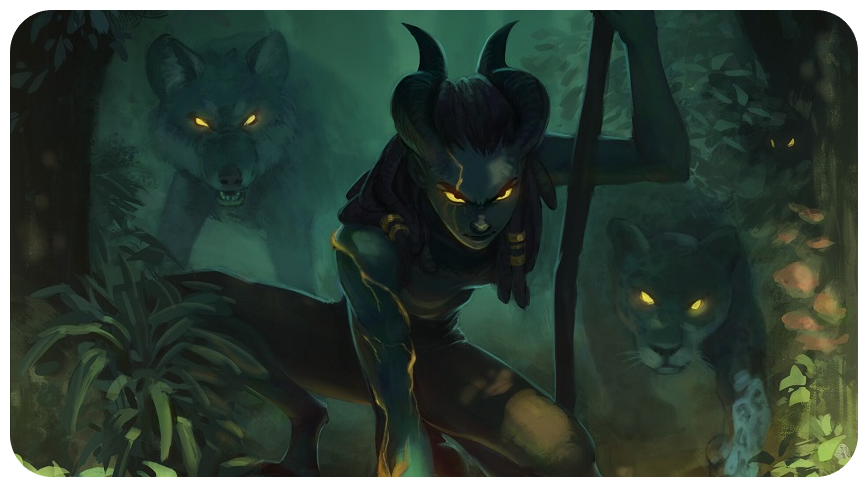
Animism
Animism is the study of Saol and nature, allowing its practitioners to form special bonds with plants and animals. Animism does not require a Minor Merit to pursue. Achieving Grandmaster in any Theorem is a Minor Merit as any mundane skill.
History
Animism can trace its ancient roots back to the Faefolk of Ælphyne. It traveled to Antarok in the arms of those they banished, those who struck a deal with Ældrassil and then became Æld'Norai. As their numbers grew and factions splintered off and moved on from the forests of Ælheim, they carried their knowledge of this sacred art with them. Today, one would be hard pressed to find a place in the world where Animism isn’t practiced, although the role it plays in each society ranges from integral to niche.
Acquisition
For some people, particularly for those raised within cultures steeped in Animism, it is almost an instinctual thing. For others, a more classic approach– learning from a mentor– is the most common, although using texts and the like for self-learning is also possible.
Concepts
Below are the concepts & abilities one will gain access to as one delves into the study of Animism.
When it comes to roleplaying academic subjects, feel free to choose your character’s level of intellect and understanding as with what fits them. For example, if you give a character Master-level Animism to utilize a CR5 Familiar, you can choose to lean into the academic portions as much (or as little) as suits them.
Glamourous Study
A lot of what an Animist will learn as they progress with this ancient field of study are the origins, tenets, and histories of each Glamour. Each student will also be taught a general understanding of Ælphyne and the Faefolk that reside there. Generally, with each tier of mastery in Animism, one's understanding will correlate to what each Glamour is capable of at that same tier.
Ecology
Given that the study of Animism is, in essence, the study of nature, a student will be taught about all manner of flora and fauna. They will also gain an understanding of how organisms, people included, interact with the environment and how all three of the aforementioned groups impact one another.
Beast Tongue
Beast Tongue is a language like any other, something one learns alongside Animism’s other tenets. By Journeyman, one will be able to reasonably communicate with any beast, though ancient creatures may scoff at the Animist’s clumsiness. Most elder beasts or those with a high Challenge Rating will be insulted by anything other than a Master’s perfect fluency, though there are some creatures with such pleasant temperaments that may forgive the Animist for this transgression.
Wildsong
The purpose of Wildsong is to pacify fauna by canting words of Saol of a matching Challenge Rating. The potency of one’s Wildsong scales one-to-one with one’s mastery of the art as a whole.
Animal Familiar
After pacifying an animal with Wildsong, an Animist may form a bond with it, taking the creature on as their Familiar. This bond is formed through a ritual that connects the pair’s souls, requiring the two of them to enter a Saol-steeped meditative trance. For most animals, the Animist will have to instruct their would-be Familiar into doing this utilizing Beast Tongue. Losing a Familiar causes catastrophic emotional pain that takes a long time to recover from, but this may be ignored with Mastery in Meditation.
- Limited to one animal with a Challenge Rating (CR) matching your skill tier, and three additional animals of a lower Challenge Rating for each lesser tier. For example, a Master Animist could have one CR5 animal familiar, three CR4, nine CR3, and so on. It is not unheard of for an Animist to have a biting swarm of CR0 insects as their CR1 'Familiar'.
- Fauna with Beast Magic will first require feeding, touching them with, or embedding within them Alkahest of that same Metaphor, equivalent to the CR of that animal. A CR6 with Luxium Beast Magic would require a Globe of Luxiite, for example. This Alkahest will be consumed as a catalyst for the bond.
You may start play with any mundane (non-magical) CR4 or less animal as your familiar(s) should you have the prerequisite skill.
Saol Communion
Fauna
By attuning their souls to their Animal Familiar, an Animist may adopt that creature's Beast Magic for themselves, channeling that creature to grow the necessary anatomy and organs to wield it. This often requires an investiture of experience and Minor Merits. See Gramarye.
- Changelings who are Animists may Incite the Beast Magic of their Imprints rather than using a Familiar to do so.
Flora
Like the above process with animals, an Animist is also capable of entering into a similar bond with plants by attuning their souls to the Saol flowing through the plant. This often requires an investiture of experience and Minor Merits. See Gramarye.
Saol Ritual
Binding Saol to the soul, the eldest of Animists are able to devise and facilitate complex rituals of life known as Saolbinding. By Expert, they are able to preside over such rituals themselves. Only a Grandmaster Animist may piece apart the vagaries of Saol and its countless mysteries in order to devise a Saolbind unknown to all others. This often requires an investiture of experience and Minor Merits. See Gramarye.
Rite of Growth
By expending Saol Alkahest equivalent to 10x the desired Challenge Rating tier, an Animist may conduct a ritual upon their Animal Familiar to strengthen and enlarge the beast, heightening its Beast Magic prowess to match that CR. The animal will break free should the Animist exceed their control.
- 10 grams of Dust: CR1
- 10 Slivers: CR2
- 10 Shards: CR3
- 10 Crystals: CR4
- 10 Spheres: CR5
- 10 Globes: CR6
Skill Tiers
Novice
Apprentice
Journeyman
Expert
Master
Grandmaster
|
Articles on Glamour
|
Definitions |
Arcana · Arcana List · Theorem · Metaphor · Ascension |
|
Glamour |
Glamour · Wild Glamour · Animism |
| Glamour [ Grist · Seeming · Shimmer · Draoidh ] | |
| Variants [ Geist · Encaustum · Tetli ] | |
| Gramarye [ Dragonbound · Förengsrit ] |
